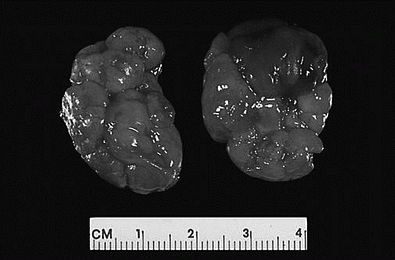SFEBES2012 Poster Presentations Clinical practice/governance and case reports (90 abstracts)
Hunting for the underlying cause of Cushing’s syndrome
Devesh Sennik 1 , Manohar Kenchaiah 1 , Hisham Elhag Ali 1 , Chaminda Garusinghe 1 , Shirley Hodgson 2 & Gul Bano 1
1The Thomas Addison Endocrine Unit, St George's Healthcare NHS Trust, Tooting, United Kingdom; 2Clinical Genetics Department, St George's Healthcare NHS Trust, Tooting, United Kingdom.
A 66 year old lady with a previous diagnosis of Retinitis Pigmentosa (RP) was referred to our endocrine clinic with excessive sweating and was also noted to have hypertension, thin skin, extensive bruising and central obesity. Her past medical history included a benign thyroid nodule, gastric erosions, osteoporosis, hyperlipidaemia and depression. On examination, blood pressure was 164/86 mmHg and BMI was 30.7 kg/m2 with central obesity. Biochemical testing revealed lack of suppression to overnight dexamethasone suppression test (Cortisol 60 nmol/l post dexamethasone). Low dose dexamethasone test followed by CRH stimulation test confirmed ACTH independent Cushing’s syndrome. ACTH levels were suppressed (<5 ng/l). ACTH precursors were <100 pmol/l, excluding ectopic ACTH production. CT and MRI scans of the abdomen confirmed bilaterally enlarged adrenal glands. A diagnosis of ACTH independent macronodular adrenal hyperplasia (AimAH) was made. Tests were then undertaken to evaluate whether excess cortisol secretion was related to abberent receptor activation. GnRH and TRH testing was normal. However, there was a significant rise in cortisol when measured sitting (226 nmol/l) compared to standing (320 nmol/l), suggesting the presence of renin/angiotensin responsive abberent receptors. She then underwent bilateral adrenalectomy and histology confirmed nodular hyperplasia. Further genetic testing revealed a microdeletion affecting the GNAS1 gene. This gene complex encodes for the α-subunit of the G protein. This couples receptor binding by several hormones to activation of adenylate cyclase. Activating mutations in the GNAS1 gene are responsible for other conditions such as McCune-Albright syndrome. The known genetic mutations responsible for RP lie very close to the GNAS1 gene complex which therefore could explain the association between these two genetic conditions in our patient. This case highlights the importance of searching for the underlying cause of Cushing’s in each case and reports the association between RP and AimAH for the first time to our knowledge.
Declaration of interest: There is no conflict of interest that could be perceived as prejudicing the impartiality of the research reported.

Macroscopic Appearance of AIMAH
Funding: No specific grant from any funding agency in the public, commercial or not-for-profit sector.




